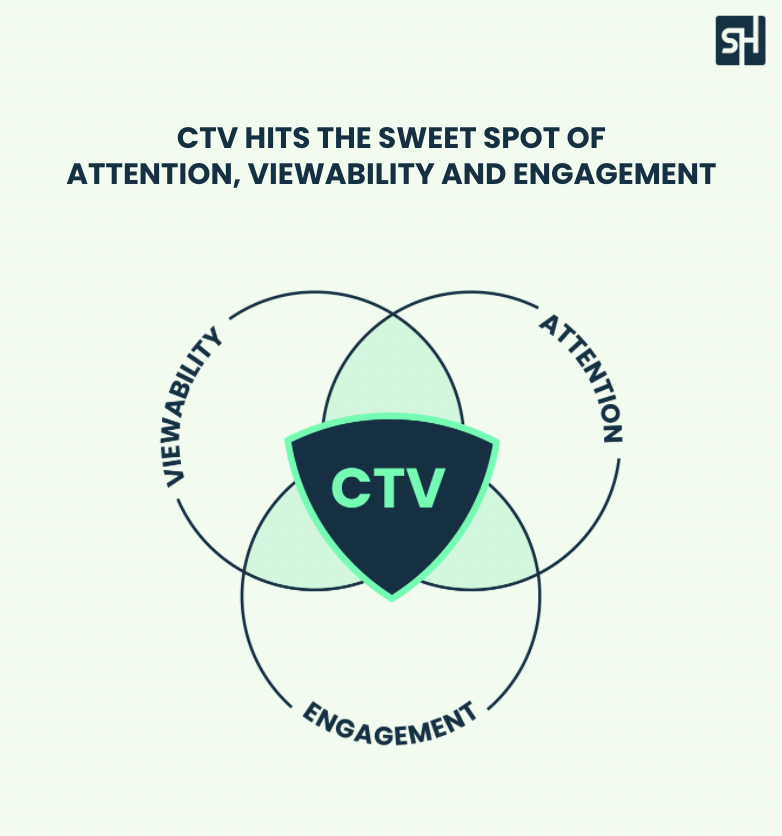By Sarah Lewis, Global Director CTV at ShowHeroes Group
CTV ownership is exploding around Europe and as ‘colour television’ eventually became a redundant term, becoming ubiquitous in living rooms, the same tipping point could be close for connected television. In the UK alone, the average home now owns nearly three connected TV devices.
With a format that’s inherently high impact, it’s little wonder that marketers are flocking to connected TV as the most promising bastion of ad spend. Intrigued by this growth curve, our team at ShowHeroes Group recently partnered with market research agency COG on a wide-ranging experiment to discover how exactly the user experience manifests in reaction to CTV content and advertising.
Since consumers tend to underestimate their own receptiveness to advertising, we used biometric methods to track the attentiveness of UK TV viewers on a subliminal level. Combining this with a large-scale survey of 2,100 participants in seven European markets, we were able to build a fascinating picture of the superpower potential of CTV.
Next-level attention and engagement
Amanda Ellison, Professor of Neuroscience at Durham University, helped us to devise the biometric part of our CTV experiment, which involved participants wearing cutting-edge Tobii eye tracking glasses, along with eSense electrodermal response sensors, as they watched linear TV and CTV in a natural home experiment.
While the eye-tracking data showed where people were looking on-screen, the electrodermal insights showed how engaged they were at that point in time – and whether or not they were overloaded by what they were watching.
The results were striking. Users showed an average attention length of 12.2 seconds for CTV ads before looking away; nearly 3 seconds longer than linear TV, and over 5x the length of user attention paid to YouTube. During CTV ad breaks, viewers were found to be in the “engagement zone” 71% of the time, according to viewers’ electrodermal responses: 11% higher than YouTube ads.
When attention and engagement results were combined, CTV viewing emerged as an obvious frontrunner for ad exposure – with 51% of viewers’ time spent in this optimal state (17% higher than linear TV, and 40% higher than YouTube).

Relevancy rules the waves
Our methodology meant we were able to peer inside the unconscious processes of CTV viewers for the first time, giving us a foothold into the nebulous measure of attentiveness. And our findings confirmed what many advertisers may already suspect: that CTV hits the sweet spot when it comes to the golden triad of viewability (big-screen exposure is inherently viewable), engagement and sky-high levels of attention.
We conducted follow-up interviews with 20 participants who commented on their own viewing footage; and this, along with the European survey, gave us further clues on how a premium CTV ad experience can take shape.
Firstly, and promisingly, ads are in demand: 57% of respondents would prefer to watch ad-supported free content rather than increase their CTV subscriptions. But there’s a caveat: 67% of users said they would prefer to watch CTV ads that are relevant to the content they’re watching.
So, advertisers can maximise their CTV returns by using semantic targeting – technology that precisely matches ads to content context at any one moment in time. This is all the more important given audiences use CTV devices most heavily in the living room, making CTV a one-to-many medium where contextual relevance trumps demographic profiling (while also abiding more closely with incoming privacy legislation).
Tailored solutions for CTV
Attention is hard to commoditize, but the value of doing so is huge. Using biometric data, we can see viewers in a relaxed, lean-back CTV environment are in the ideal mental state for remembering messages; they’re far less distracted, and more receptive to relevant brand stories.
They’re prone to action, too: our study found 43% of users searched for a product after seeing a CTV ad, and 1 in 5 bought a product. But this isn’t just about the bottom line. Yes, advertisers can work with partners to contextually target CTV content; and in a standardised way that accurately measures attention (the emerging CTV ecosystem still has work to do in creating consistent benchmarks). Similarly, publishers can work on enriching their content metadata and EPG data – positioning themselves for lucrative CTV gains to come.
Yet, we now know that CTV advertising is a perfect platform for engagement. It commands user attention that’s so rich, it may even warrant a cutoff from the click-based mania of yesteryear. In a future world, marketers could trade their quick-win performance metrics with a more holistic strategy. This tailored approach will recognise that we can trust CTV to deliver great ad experiences; but also that those experiences become even better by evolving the format in the best possible manner.
This means developing a nuanced understanding of context, paired with deep creativity that speaks to the CTV’s cinematic appeal. In doing so, the advertising ecosystem can garner the attention that’s gone AWOL in an age of digital overload, becoming the comeback star it was born to be.










